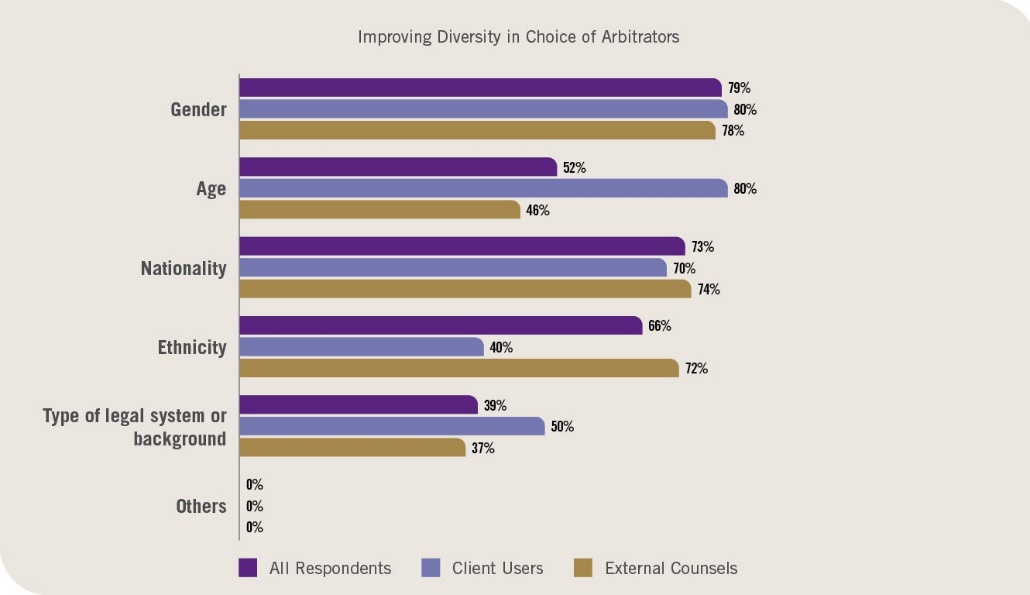
Arbitration in Focus
Reactions to SIDRA’s International Dispute Resolution Survey
This second instalment of a three-part series of articles focuses on international commercial arbitration – why parties opt to arbitrate their commercial disputes, their satisfaction with arbitration, and the factors important to them in choosing an arbitral institution and arbitrators. In Part One, we looked at what makes the SIDRA Survey unique and the trends in international commercial mediation.
The Singapore International Dispute Resolution Academy (SIDRA) launched its SIDRA International Dispute Resolution Survey in 2019. In 2021, SIDRA conducted the second iteration of the Survey and issued its Survey Final Report in August 2022. The 2022 Final Report sets out the findings of the second run of the SIDRA Survey, which was conducted to better understand user experience and satisfaction with different international dispute resolution mechanisms, including international commercial arbitration, mediation, and litigation.
All international respondents to the SIDRA Survey are identified as Client Users (corporate executives and in-house counsel) or External Counsels (dispute resolution lawyers and corporate lawyers) who engage in cross-border commercial dispute resolution. All respondents are actual users of international dispute resolution mechanisms; views of neutrals, academics, institutional providers, and other non-user stakeholders are not represented. Majority of the respondents come from Asia, with 42.4 per cent based in Singapore.
To better understand the findings of the Survey on international commercial arbitration through the perspectives of an arbitral institution, we spoke with Gloria Lim, CEO of the Singapore International Arbitration Centre (SIAC). The SIAC is an independent, not-for-profit organisation that provides case management services in relation to arbitration proceedings. SIAC is one of the most commonly used arbitration institutions in the SIDRA Survey Final Report 2022, as well as the SIDRA Survey Final Report 2020. SIAC is well-known for its progressive institutional rules, diverse panel of arbitrators, and flexible cost structures.
Factors Affecting User Decision to Use Arbitration
Speed and Cost
Respondents were asked what were the important factors that affected their decision to use arbitration to resolve their cross-border commercial disputes. 82 per cent of respondents ranked direct enforceability as important or absolutely crucial in choosing arbitration. This illustrates the impact that the Convention on the Recognition and Enforcement of Foreign Arbitral Awards, also known as the New York Convention, has had on the ability to enforce arbitral awards across different jurisdictions.
Speed (79 per cent) and cost (63 per cent) were some of the characteristics that respondents found to be important or absolutely crucial in opting to arbitrate their disputes.
Respondents were also asked about their satisfaction with arbitration as a mechanism. 41 per cent of respondents were satisfied with the speed of arbitration and only 30 per cent of respondents were satisfied with the costs associated with arbitration. These data tracks with international findings regarding the criticism against the speed and related cost of international commercial arbitration.1See George A. Bermann, The Future of International Commercial Arbitration, The Cambridge Companion to International Arbitration, C. L. Lim (Ed.), Cambridge University Press (2021), available at: https://scholarship.law.columbia.edu/faculty_scholarship/3305

Exhibit 1. Importance of factors affecting the decision to use arbitration and satisfaction with mediation as a mechanism according to factor
In speaking with the CEO of SIAC, we wanted to find out how the arbitration centre addressed this issue. CEO Lim acknowledges that speed and costs are intrinsic to what businesses are concerned about. She further shared that businesses generally expect that going through an arbitration proceeding would produce some cost or time savings, as compared to litigation alongside other advantages that arbitration brings, such as confidentiality and choice of arbitrator. CEO Lim believes that arbitral institutions play a role in helping manage the costs of an arbitration proceeding through its institutional rules and case management services. This is why the SIAC has measures in place to help manage costs. For instance, the SIAC implements fee caps on its administration fees, as well as arbitrator’s fees. The SIAC administration fees, which are independent of parties’ legal costs and usage cost (cost of facilities and support services for hearings) and arbitrator’s fees, are based on an ad valorem system, or on a sliding scale depending on the amount in dispute. The SIAC also has a ceiling on the amount payable to SIAC itself and to each arbitrator. Parties have the option to agree on alternative methods of determining arbitral tribunal’s fees prior to the constitution of the tribunal.2Rule 34.1, SIAC Rules 2016. Through this, parties get a clear sense of what the maximum administration and arbitrator costs are at the very outset of a case.
To make the process more efficient, the SIAC provides for specific time periods to file submissions, appoint arbitrators, and even to issue an award. The SIAC Rules 2016 requires that the arbitral award be submitted to the Registrar not later than 45 days from the date on which the tribunal declared the proceedings closed unless the Registrar extends the period of time or otherwise agreed by the parties.3Rule 32.3, SIAC Rules 2016.
In terms of procedural innovations, SIAC’s Rules include an expedited procedure which can apply under certain circumstances, where the final award will be issued within six months of the constitution of the tribunal, unless the Registrar extends the time for making the final award.4Rule 4, SIAC Expedited Procedure. The SIAC also offers emergency arbitration, where an emergency arbitrator is appointed to hear applications for urgent relief before the constitution of the arbitral tribunal. CEO Lim shared that the SIAC was one of the first institutions to introduce provisions for expedited procedure and emergency arbitration, and SIAC has become one of the global leaders in these procedures.
Procedural Flexibility and Clarity in Rules and Procedure
81 per cent of all international respondents to the SIDRA Survey indicated that procedural flexibility was an important or absolutely crucial factor affecting their decision to use arbitration. 71 per cent of the respondents thought that the clarity and transparency in rules and procedures were important or absolutely crucial in choosing to arbitrate a dispute. In terms of satisfaction, 76 per cent of respondents were very satisfied or somewhat satisfied with the procedural flexibility that arbitration brings and 66 per cent were satisfied with the clarity and transparency in rules and procedures.
Arbitration is well-known to be a flexible process that allows parties to tailor-fit procedures to their needs. To assist parties, CEO Lim said that the SIAC strives to give parties tools to deal with their dispute that matches their needs. Recently, the SIAC revised its Model Clause to give parties the option to choose the Singapore International Commercial Court (SICC) as the supervisory court for Singapore-seated arbitrations. The SICC is a division of the General Division of the Singapore High Court and hears cross-border commercial disputes.5Overview of the SICC, available at https://www.sicc.gov.sg/about-the-sicc/overview-of-the-sicc Judges at the SICC are a mix of Singapore and international judges with expertise in cross-border commercial disputes. In the final part of this series of articles, we will look at user expectations and satisfactions in international commercial litigation and discuss the reactions of Mr Laurence Wong, Senior Director of the SICC to the SIDRA Survey findings on international commercial litigation.
Ordinarily, if Singapore is the seat of the arbitration, it is the General Division of the High Court of Singapore that serves as the supervisory court of the arbitration. Should parties incorporate the optional clause of the new SIAC Model Clause into their contracts and expressly choose the SICC, it will be SICC’s international judges that will hear the case following the SICC Court Rules. CEO Lim hopes that the new SIAC Model Clause will give parties another plug and play option that will assist them in resolving disputes.
Mixed Mode or Hybrid Mechanisms
Mixed mode or hybrid dispute resolution mechanisms allow parties to a dispute to combine two or more dispute resolution processes such as mediation, non-binding evaluation, arbitration or litigation. Of the respondents to the SIDRA Survey who have used hybrid dispute resolution procedures, 76 per cent have had experience with mediation-arbitration and 41 per cent have had experience with arbitration-mediation-arbitration, or Arb-Med-Arb.
CEO Lim commented that hybrid processes provide parties with another option that can be mixed and matched. With the growing interest in mixed mode or hybrid mechanisms, the SIAC also has an Arbitration-Mediation-Arbitration, or Arb-Med-Arb, Protocol with the Singapore International Mediation Centre (SIMC) in place. Parties can include the “Singapore Clause” for the Arb-Med-Arb (AMA) protocol in their contracts or agree to the adoption of the AMA protocol after the dispute arises. Through the protocol, parties are able to combine the advantages of mediation with the enforceability and finality of arbitration. Parties who want to commence an arbitration under the AMA Protocol shall file with the Registrar of the SIAC a notice of arbitration.6SIAC-SIMC Arb-Med-Arb Protocol, para. 2. The SIAC will then automatically refer the case to SIMC for mediation.7Id, para. 3. The mediation shall be completed within eight weeks from the referral.8Id, para. 6. If the parties end up settling their dispute through the mediation process, their mediated settlement agreement can be recorded as an arbitral award. Otherwise, parties may proceed with the arbitration. Given the close collaboration between the SIAC and SIMC, they offer efficient and reliable case management services. Parties are able to transition between arbitration and mediation easily and need not take any additional steps to transfer their cases between the two institutions. The SIAC takes care of referring the case to mediation and is solely responsible for collecting related fees.9Id, paras. 10-15.
Arbitrator Appointments and Diversity
The SIAC maintains a panel of arbitrators from over 40 jurisdictions. Parties are not required to appoint an arbitrator from the panel and are free to nominate an arbitrator of their choice outside the panel.
Respondents to the SIDRA Survey were asked whether they considered diversity, in terms of gender, age, nationality, ethnicity, type of legal system or background, was important in the selection of an arbitrator. 44 per cent of respondents said that diversity was important. 13 per cent thought it was absolutely crucial.
The majority of international respondents would like to see more diversity in the gender of arbitrators (79 per cent). Respondents would also like to see improvements in nationality (73 percent) and ethnicity (66 per cent) in their choice of arbitrators.

Exhibit 2. Improving diversity in gender, age, nationality, ethnicity, or type of legal system or background in arbitrator appointments
In exploring the issue of arbitrator diversity, CEO Lim shared that she believes that institutions play a role in creating and maintaining a diverse pool of arbitrators. She also takes the view that institutions have a duty to give rising talent their first appointments and thus, help build the future pool of arbitrators. But she advised that arbitrator appointments should not be diverse just for the sake of diversity. Diversity should be juxtaposed against the expertise needed for a particular dispute as it is important that parties still get “the best person for the job”. In 2022, arbitrators from 36 jurisdictions were appointed to serve on SIAC-administered arbitrations. 46.2 per cent of arbitrators that the SIAC appointed were women, an increase from 35.8 per cent in 2021.10SIAC Announces 2022 Statistics, Q1 2023 Sees High Filings, available at https://siac.org.sg/wp-content/uploads/2023/04/Press-Release-SIAC-Annual-Report-2022-1.pdf This is in line with the positive trends of ascending women appointments in international commercial arbitration; for example, in 2021 women made up 40 per cent of all arbitrator appointments by International Chamber of Commerce Court of Arbitration.11ICC Acts to Encourage Diversity in Selection of Arbitrators, ICC Arbitration, 30 November 2022, available at ICC acts to encourage diversity in selection of arbitrators – ICC – International Chamber of Commerce (iccwbo.org)
CEO Lim shared that the SIAC is constantly striving to achieve a process design that would ensure a trusted and efficient case management system for the parties. They are actively looking into improving their rules, leveraging technology to benefit the arbitral process, sharing experiences with partner institutions, and promoting and raising awareness about arbitration. At the end of the day, CEO Lim hopes to tailor fit SIAC services to what the market calls for and what users need.
SIDRA is currently running the third iteration of its International Dispute Resolution Survey. The 2023 SIDRA Survey is currently open for participation. It is you – users of international dispute settlement systems (mediation, arbitration, litigation, mixed mode (hybrid) mechanisms), who determine the outcome of the Survey; it is you whose voice is decisive in devising the most efficient and effective dispute resolution processes. Your contributions are highly valuable to us. You are invited to contribute to the ongoing SIDRA Survey, which you will find here.
Endnotes
| ↑1 | See George A. Bermann, The Future of International Commercial Arbitration, The Cambridge Companion to International Arbitration, C. L. Lim (Ed.), Cambridge University Press (2021), available at: https://scholarship.law.columbia.edu/faculty_scholarship/3305 |
|---|---|
| ↑2 | Rule 34.1, SIAC Rules 2016. |
| ↑3 | Rule 32.3, SIAC Rules 2016. |
| ↑4 | Rule 4, SIAC Expedited Procedure. |
| ↑5 | Overview of the SICC, available at https://www.sicc.gov.sg/about-the-sicc/overview-of-the-sicc |
| ↑6 | SIAC-SIMC Arb-Med-Arb Protocol, para. 2. |
| ↑7 | Id, para. 3. |
| ↑8 | Id, para. 6. |
| ↑9 | Id, paras. 10-15. |
| ↑10 | SIAC Announces 2022 Statistics, Q1 2023 Sees High Filings, available at https://siac.org.sg/wp-content/uploads/2023/04/Press-Release-SIAC-Annual-Report-2022-1.pdf |
| ↑11 | ICC Acts to Encourage Diversity in Selection of Arbitrators, ICC Arbitration, 30 November 2022, available at ICC acts to encourage diversity in selection of arbitrators – ICC – International Chamber of Commerce (iccwbo.org) |






